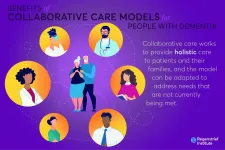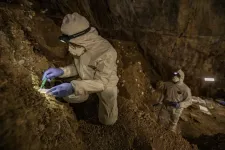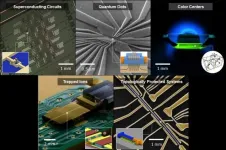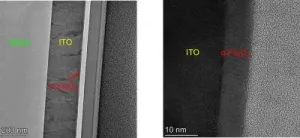Attacking aortic aneurysms before they grow
2021-04-19
(Press-News.org) A new study investigates a genetic culprit behind abdominal aortic aneurysm, a serious condition that puts people at risk of their aorta rupturing - a potentially deadly event.
Finding a viable genetic target for AAA could change the game, says senior author Katherine Gallagher, M.D., a vascular surgeon and an associate professor of surgery and microbiology and immunology at Michigan Medicine, the academic medical center of the University of Michigan.
That's because there are no medications to directly treat the condition and prevent an aneurysm from growing. Current options include things like addressing blood pressure to lower the stress on the arteries and veins running through the body, and making lifestyle changes like quitting smoking. Most people monitor their aneurysm to see if it grows enough to eventually require endovascular or open surgical repair.
For this study, a team of Michigan Medicine researchers investigated the role of an epigenetic enzyme called JMJD3 in the development of AAAs. They found the gene was turned on in both people and mice who had an AAA and that the gene promoted inflammation in monocyte/macrophages. When they blocked the enzyme, it prevented an aneurysm from forming.
"Targeting the JMJD3 pathway in a cell specific-manner offers the opportunity to limit AAA progression and rupture," says lead author Frank Davis, M.D., a vascular surgery resident at the Frankel Cardiovascular Center.
"We are the first to perform an extensive single-cell RNA sequencing and gene expression analysis on human AAAs and non-aneurysmal aortic control samples," Gallagher adds.
INFORMATION:
ELSE PRESS RELEASES FROM THIS DATE:
2021-04-19
COLUMBUS, Ohio - Someday, scientists believe, tiny DNA-based robots and other nanodevices will deliver medicine inside our bodies, detect the presence of deadly pathogens, and help manufacture increasingly smaller electronics.
Researchers took a big step toward that future by developing a new tool that can design much more complex DNA robots and nanodevices than were ever possible before in a fraction of the time.
In a paper published today (April 19, 2021) in the journal Nature Materials, researchers from The Ohio State University - led by former engineering doctoral student Chao-Min Huang - unveiled new software they call MagicDNA.
The software helps researchers design ways to ...
2021-04-19
BRAZZAVILLE, Republic of Congo (April 19, 2021) - A new study classifies different types of wildlife traffickers and sellers in two of Central Africa's growing urban centers, providing new insight into the poorly understood urban illegal wildlife trade. The findings can help conservation and law enforcement authorities prioritize their efforts on professional criminals, identify patterns among repeat offenders, and determine if wildlife offenders are engaging in other types of crime.
Authors from the University of Maryland and Wildlife Conservation Society (WCS) describe their findings ...
2021-04-19
INDIANAPOLIS -- A new report from the National Academies of Sciences, Engineering, and Medicine (National Academies) details the state of dementia care and research in America and provides guidance on future research to make sure both patients and their families are having their needs met by the care they receive. Sections of the report highlight the effectiveness of the collaborative care model as well as successful implementation, citing research from Regenstrief Institute, Eskenazi Health and the Indiana University School of Medicine.
There are between 3.7 million and 5.8 million people living with dementia ...
2021-04-19
Scientists have sequenced ancient DNA from soil for the first time and the advance will transform what is known about everything from evolution to climate change.
The findings have been described as the 'moon landings' of genomics because researchers will no longer have to rely on finding and testing fossils to determine genetic ancestry, links and discoveries - and it is thanks to Stone Age black bears who defecated in a remote cave in Mexico 16,000 years ago.
A team of scientists from The Lundbeck Foundation GeoGenetics Centre, University of Copenhagen, led by Professor Eske Willerslev, director of the foundation and a Fellow of St John's College, University of Cambridge, recreated ...
2021-04-19
April 19, 2021 - An estimated 50 million people undergo surgery each year in the United States, and a significant proportion of them have undiagnosed or untreated sleep disorders (SD) or sleep-disordered breathing (SDB). Issues at the intersection of anesthesiology and sleep medicine are the focus of the Society of Anesthesia and Sleep Medicine (SASM) whose 10th anniversary is commemorated in the special theme May issue of Anesthesia & Analgesia.
The special issue looks back at a remarkable first decade of achievements in research and clinical practice by this young subspecialty society, while looking forward to further progress. A key ...
2021-04-19
More blood thinners aren't automatically better, another study confirms.
A new publication in JAMA Internal Medicine focuses on the minimal pros and the concerning cons of combining a daily aspirin with a drug from the newer class of anticoagulants that include apixaban, dabigatran, edoxaban and rivaroxaban.
Patients were taking one of these direct oral anticoagulants known as DOACs to prevent strokes from non-valvular atrial fibrillation or for the treatment of venous thromboembolic disease (deep vein thrombosis or pulmonary embolism). The included patients did not have another reason to take aspirin ...
2021-04-19
PHILADELPHIA - A new gene therapy for one of the most common forms of congenital blindness was safe and improved patients' vision, according to initial data from a clinical trial led by researchers at the Scheie Eye Institute in the Perelman School of Medicine at the University of Pennsylvania.
The therapy delivers working copies of GUCY2D to the eyes of patients who have severe vision impairments caused by mutations in the gene. Each of the first three treated patients experienced improvement in some aspects of vision, without serious side effects, according to the new study, published in the journal iScience.
"We found sustained improvements in both day and night vision, even with a relatively low dose of the gene therapy," said study lead author Samuel G. Jacobson, MD, ...
2021-04-19
A new study outlines the need for materials advances in the hardware that goes into making quantum computers if these futuristic devices are to surpass the abilities of the computers we use today.
The study, published in the journal Science by an international team, surveyed the state of research on quantum computing hardware with the goal of illustrating the challenges and opportunities facing scientists and engineers.
While conventional computers encode "bits" of information as ones and zeroes, quantum computers breeze past this binary arrangement by creating "qubits," which can be complex, continuous quantities. Storing and manipulating information ...
2021-04-19
JACKSONVILLE, Fla. -- In a new paper published in Nature Communications, Mayo Clinic researchers and collaborators report the protein-coding gene SERPINA5 may worsen tau protein tangles, which are characteristic of Alzheimer's disease, and advance disease. By combining clinical expertise, brain tissue samples, pathology expertise and artificial intelligence, the team clarified and validated the relevance of the gene to Alzheimer's disease.
The researchers used tissue samples from 385 brains donated to the Mayo Clinic Brain Bank, which houses more than 9,000 brain tissue specimens for the study of neurodegenerative disorders. The samples were from people who were diagnosed with Alzheimer's disease and lacked co-existing diseases found in ...
2021-04-19
Hydrogen will be needed in large quantities as an energy carrier and raw material in the energy system of the future. To achieve this, however, hydrogen must be produced in a climate-neutral way, for example through so-called photoelectrolysis, by using sunlight to split water into hydrogen and oxygen. As photoelectrodes, semiconducting materials are needed that convert sunlight into electricity and remain stable in water. Metal oxides are among the best candidates for stable and inexpensive photoelectrodes. Some of these metal oxides also have catalytically active surfaces that accelerate the formation of hydrogen at the cathode or oxygen at the anode.
Why is rust not much better?
Research has long focused on haematite (α-Fe2O3), ...
LAST 30 PRESS RELEASES:
[Press-News.org] Attacking aortic aneurysms before they grow




